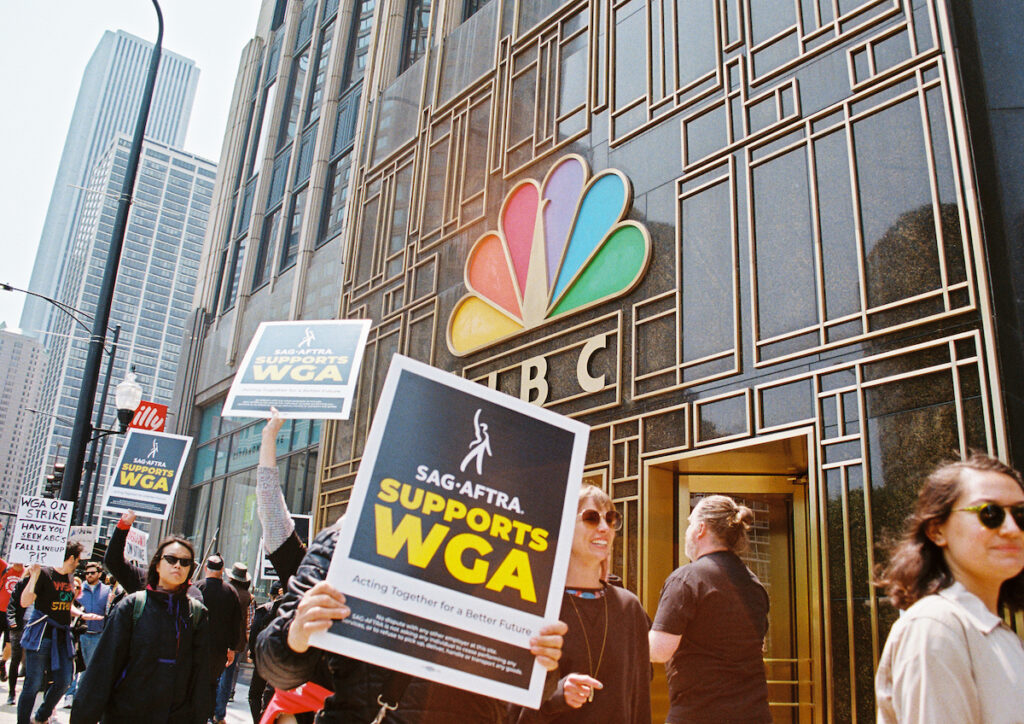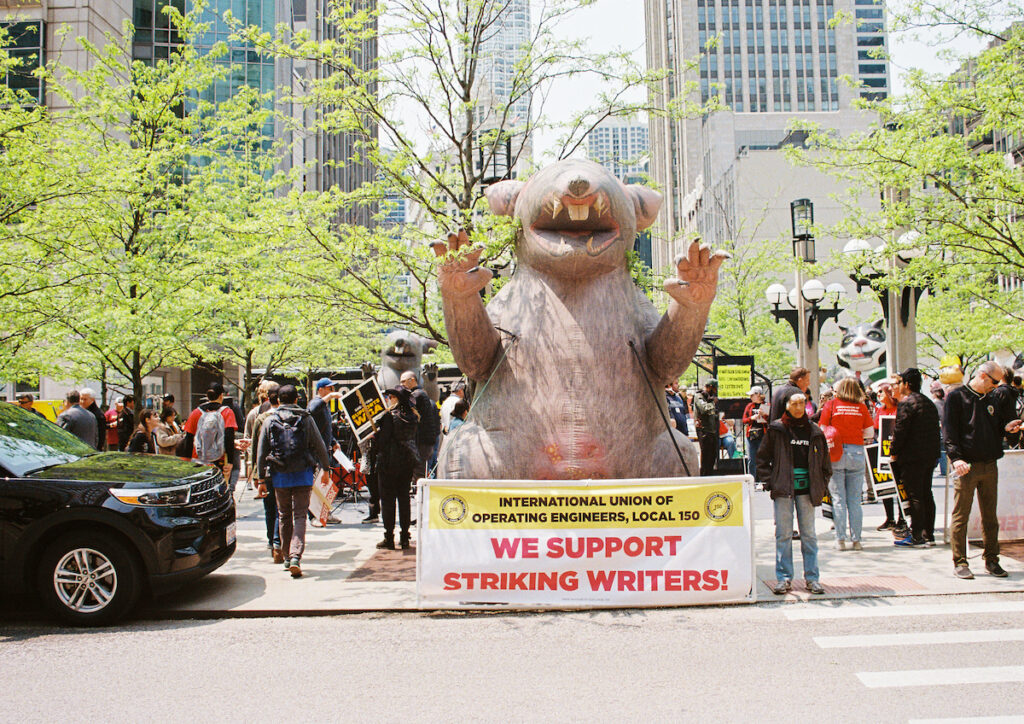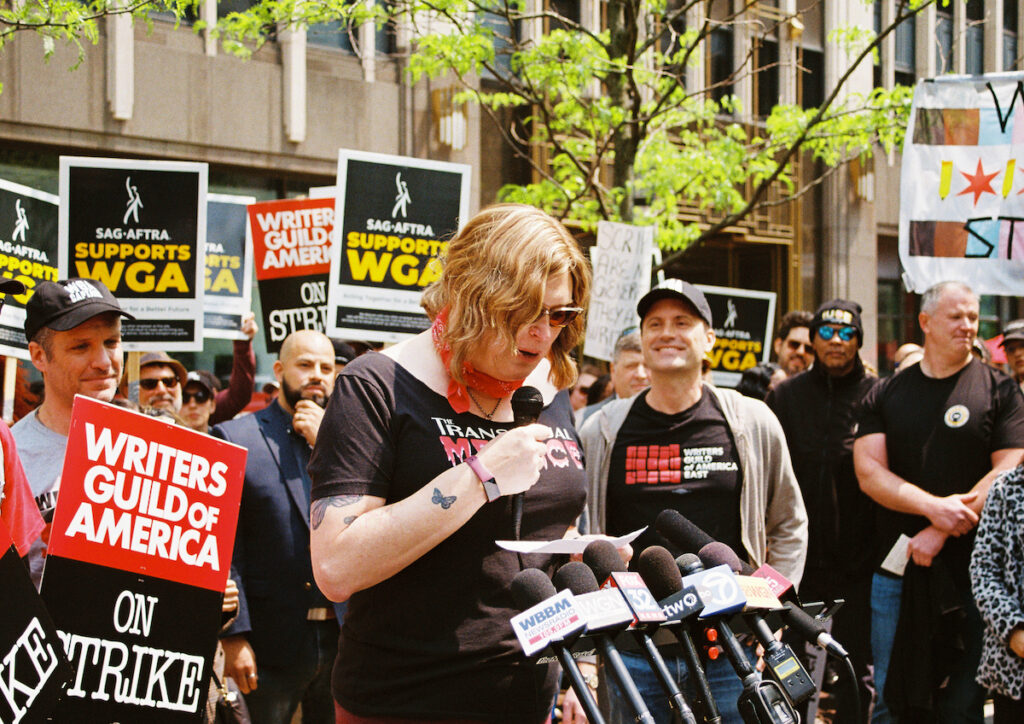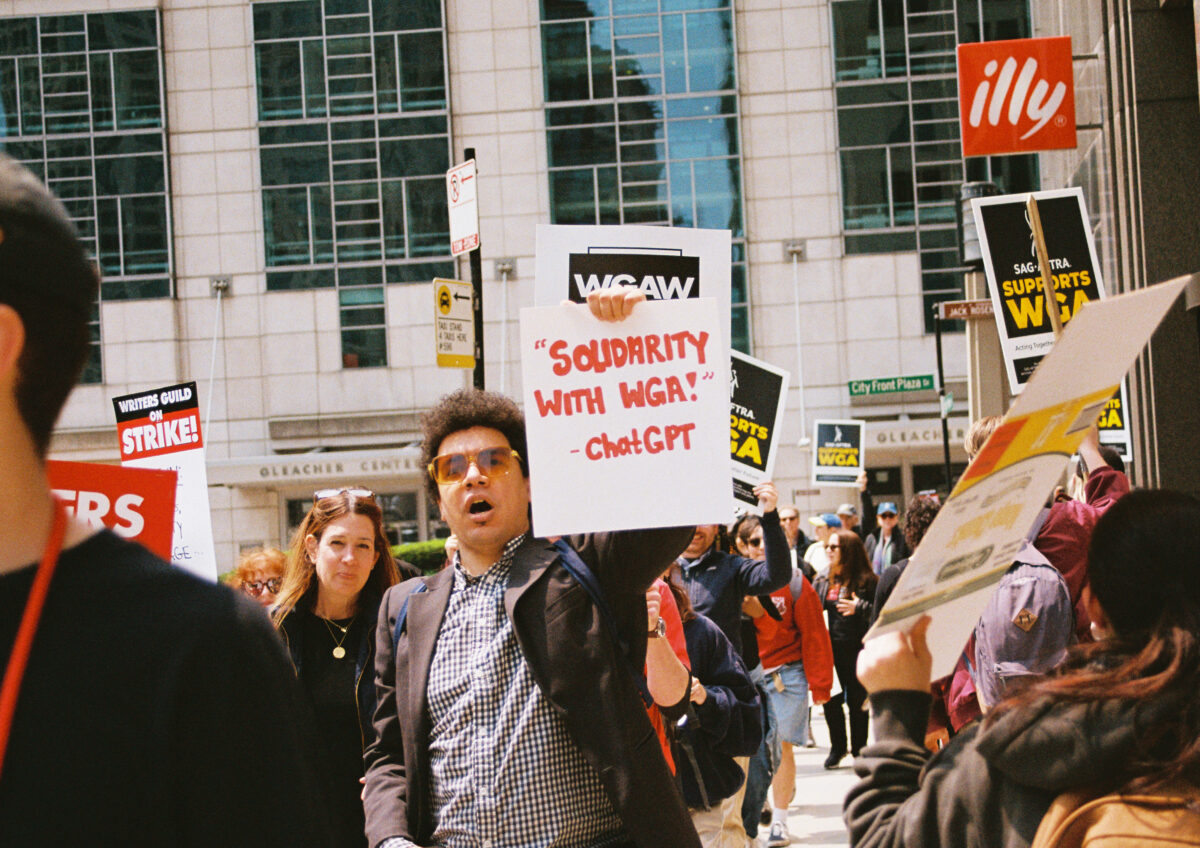On May 2, after more than six weeks of negotiations, the Writers Guild of America (WGA), representing some 11,000 writers of film, TV, and digital media productions, went on strike for better wages and work environments, among other issues. It’s the first writers’ strike since 2007, which lasted one hundred days. The ripple effects of this strike have impacted many other cities where production happens, including Chicago.
Chicago-based shows such as The Chi have paused production amidst the current strike. In addition to lost income for striking writers, workers from unions that are showing up in solidarity and not crossing the picket line, such as the International Alliance of Theatrical Stage Employees (IATSE), could also be affected.
On May 17, union members from across all sectors picketed outside NBC Tower in Chicago in solidarity with strikers on the West and East coasts and created their own picket lines outside of Chicago’s Cinespace Studios a week earlier. Many echoed, “Chicago’s a union town” at both of these events, touching on Chicago’s history of unions and individuals standing up to fight for better wages, working environments, and equitable spaces.

The conditions that led to the WGA strike have been brewing for years. The WGA has identified a number of reasons for these growing disparities and is fighting to address them. In the last decade, residuals—the money writers are paid when a show has reruns—have been sliced. Mini rooms are replacing standard writers’ rooms, meaning fewer writers doing the same work in less time. The WGA is fighting the potential use of artificial intelligence (AI) to replace writers and the common practice of canceling a show prematurely to avoid pouring money into its production.
Since 2013, Netflix has gained 200 million subscribers, and its numbers are still growing; in the first quarter of 2023, it gained another 1.75 million subscribers. Disney Plus gained over 130 million subscribers just in the last three years. Despite streaming being a lucrative business, writers are hardly reaping what they sow.
“Since 2017, streaming businesses have garnered approximately $30 billion a year on average,” said Ricardo Gamboa, South sider, professional screenwriter, and member of WGA East and Screen Actors Guild-American Federation of Television and Radio Artists (SAG-AFTRA). “During these same five years, compensation for writers went down by twenty-four percent.” Gamboa worked on seasons three through five of The Chi as a staff writer, story editor, and producer, and has created plays The Wizards, BRUJOS and Meet Juan(ito) Doe, as well as the news show and podcast The Hoodoisie.
The CEOs of streaming platforms such as Discovery, Disney Plus, and Netflix make upwards of $30-40 million a year. Meanwhile, many writers are barely making enough to cover rent, and some are having to pick up multiple jobs on the side while awaiting other gigs. For those who are on the opposite side of the screen, the consumers, what goes into the creation of our favorite shows is often left to be a mystery. Those bringing in big checks are actually a very low percentage of screenwriters. Alex O’Keefe, a staff writer on the award-winning Apple TV series The Bear, shot and based in Chicago, told the New Yorker that he attended the WGA awards ceremony with a “negative bank account [balance] and dressed in a bowtie purchased with credit.”

The WGA’s proposals to alleviate these issues during negotiations with the Alliance of Motion Picture and Television Producers (AMPTP) were countered with meager offers or rejected. The WGA wants to increase weekly rates of staff writers, story editors, and executive story editors—some of the lowest paying positions and mostly occupied by BIPOC—by six percent, five percent, and five percent respectively. The AMPTP countered with four percent, three percent, and two percent. WGA’s ask for an increase in the duration of employment by ensuring they are guaranteed at least ten weeks for pregreenlit rooms and up to fifty-two weeks for postgreenlit rooms—was also rejected. A proposal for AI to be regulated on MBA (master of business administration) projects and for it to not be used to create or rewrite material was rejected; instead, the AMPTP offered “annual meetings to discuss advancements in technology.”
For many writers, depending on factors such as accurate residuals and fair compensation can be the difference between making a living or struggling. Residuals provide a large sum of a writer’s income and often keep them afloat while awaiting their next project. Residuals are union-negotiated payments that writers receive when the production they worked on is played again after its initial release. However, reruns or “reairs” seem to almost be a thing of the past now. You can catch up on or binge shows in one sitting, and writers aren’t making anything off of an episode getting streamed more than once.
When streaming was initially brought on the scene, there was justifiable pushback toward how this new method would impact the way writers would get paid. “We agreed at the time [of the 2007 strike] to take a lower residual rate because streaming was so new and the studios argued they didn’t know if it was going to be profitable or not. Now it is profitable, so they need to give us the same amount we would be getting for broadcast or cable—they are refusing to do that,” said Kyra Jones, an award-winning Chicago/LA-based artist, educator, activist, professional screenwriter, and WGA/SAG union member. Jones is a staff writer on Hulu’s original series Woke as well as ABC’s Queens and the creator of The Right Swipe, Good Vibes Only, and Go To The Body.

Mini-rooms being utilized over standard writers’ rooms have ultimately shortened the writing time by not only reducing the number of writers on the team but also shortening how long they are working on the show. A standard writer’s room is ten or more writers working on a show’s full season pre- and post-production; now it’s common for that to be reduced to maybe five working on a show preproduction, and they may not even be called back for the rest of the show. “There are some writers’ rooms that the studios expect you to write a whole season of TV in like five or seven weeks,” said Jones. “You’re hustling to get the season done, and you’re getting less pay.”
The lack of livable wages in the industry is a deterrent for writers who don’t live in industry-dominating cities, such as LA or New York. “I do think that the centralization of writers’ rooms in Los Angeles is a detriment,” said Jones. “It’s cutting off talent from other cities and cutting off talent who might not have the privilege to be able to pick up and move to Los Angeles.”
That means writers’ rooms for shows based in Chicago are mostly happening in New York or Los Angeles, with few, if any, Chicago voices at the table to fact-check. Chicago-themed shows such as 61st Street and South Side also fell victim to the practice of producers pulling the plug on shows to avoid pouring money into their production. South Side, in particular, was a part of the wave of cancellations orchestrated by Max (formerly HBOMax) that took away shows like Legendary, Love Life, and Westworld.
Gamboa argued there should be just as many opportunities to work on shows in cities like Chicago as there are in New York or LA. “The creativity and ingenuity of Chicago’s communities of color are often overlooked for transplant artists or credentialed creatives that have been sanctioned by institutions. So, I say support the creator down the block—listen to the storytellers on your block,” they said.
The strike could affect Chicago writers, and the city’s broader film industry, in a number of ways. The Chicago Film Office that normally lists current shows under production has deleted all production information and its place reads a message, “postings will be listed on this page when they are available. Please check back with us.” Showtime series The Chi attempted to continue shooting the show’s sixth season despite the picket lines, going so far as to tell workers to show up to movie and film studio Cinespace by 4am to avoid picketers. Many union members from IATSE, SAG/AFTRA, and Teamsters Local 727 were out as early as 3am outside the studio in Little Village, holding down the picket line and shutting down production.
This pause in production could have an impact on the city’s revenue and business sector. Just in 2021, film and TV production revenue cultivated in Illinois from different fees, permits, and set hiring hit a record high of $630 million. The official Chicago government site states, “Film, TV, and media projects provide an economic impact to the state, where communities, residents, and local businesses, benefit with the money spent in the local economy and the jobs created by their projects.”
Other issues many strikers are fighting against is the overall lack of diversity in writers’ rooms and the overt racism perpetrated by studios. In 2020, white men held the largest share of TV employment (37.4 percent), with white women (25.9 percent), BIPOC women (21.4 percent), and BIPOC men trailing behind (15.3 percent). Oftentimes writers of color will be kept in the staff writer position, the entry-level role with the lowest pay, for multiple projects they work on.
“BIPOC women make up significant shares of lower-level writers. BIPOC women writers make up the smallest share of EPs [executive producers] and showrunners at 7.4 percent and 6.9 percent, respectively,” stated an inclusion report done by the WGA. The report found that in 2020, white men made up 63.8 percent of executive producer roles, one of the highest-paid positions which can pull in an average salary of over $100,000, while BIPOC only held 6.9 percent of those positions. Non-Black writers, particularly white men, left entry-level positions and climbed up to some of the higher roles more often than other groups.
Writers of color see a stark difference in the range of opportunities available to them and the chance to advance in their careers. “If you’re Black or a person of color, you stay at the bottom. With no promise of elevation. Just grind and be quiet,” said Sydney Charles, a multidisciplinary artist, actor, and member of SAG-AFTRA and the Actors Equity Association. “Unless you are asked what can they do to not look racist or sexist or homophobic or transphobic, knowing damn well the global majority are the ones moving and shaping society and culture,” she added. Aside from her myriad award-winning theatrical performances, Charles has also been in many Chicago-shot shows such as Southside, The Chi, Empire, and xShameless.
As striking writers risk losing work opportunities, unemployment benefits, and healthcare, they’re asking for support from media consumers. “I think that the best way right now to help the writers is to spread awareness and to spread accurate information because a lot of the publications like deadline or variety, they have vested interests in the studios and their success,” said Jones. “So if you’re going to look for accurate information, follow WGA on Twitter, go on the WGA website, follow actual WGA writers on social media, and try to amplify those messages and that information rather than the confusing inaccurate kind of scare tactics that we’re hearing from the studios.”
The last strike lasted one hundred days, and many WGA members expect to be on strike for as long as possible until their demands are met. Many WGA members have asked the public for support by joining those on the picket lines if you are in New York or LA, or keeping up with what’s going on in your city if protests are happening there. Uplift their voices by circulating their demands on socials and reading up on updates listed on the WGA strike website, including their demands, their proposals to AMPTP, and more ways you can get involved.
In the end, writers are striking to make studios recognize the value in their work and move away from a system that prioritizes who can put out a product the fastest and bring in the most revenue. “As a society, we have removed the humanism of art. The general public no longer sees it as a means of forming awareness of self or shaping the collective memory. Now it’s just how fast you can make it and how much money it can make,” said Charles. “Completely abandoning what makes art such a necessary part of life, the connection to the soul.
“That’s why artists are necessary. That’s why truth is necessary. I truly desire for all artists and art supporters and art investors to go back to the heart of the matter. The heart of the matter is the matter of the heart. Without it, society as we know it, will die.”
Alycia Kamil is multi-medium artist, educator, and freedom fighter from the South Side of Chicago.




I thought it was a prolific piece. The research definitely gave more knowledge on the writers strike than I heard before.